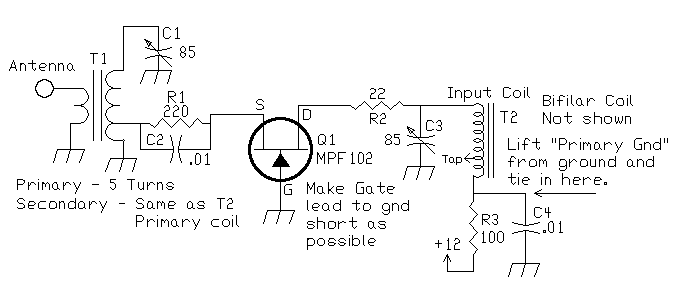

If Your Not Using a Resonant Antenna

|
Not much gain is wanted here because you can easily overload the NE602 front end. Taping down on the output coil will decrease gain. On the higher frequency bands, you can use more gain, but the amplifier is more prone to oscillation. The tap suggested for winding T2 (Input Toroid) will work OK. T2 is the original input coil on the PCB board. The ground on the primary winding is lifted and the RF amplifier power (with the 100 ohm resistor and .01 bypass cap) is tied in at that point. The connection for the tap and the bifilar secondary coil are not shown in the schematic. On 80 and 17 meters there will be an additional capacitor arcross C1 and C2 (the 85pf orange colored trimmers) to resonate them to either the 80 (300pf) or 17 (40pf) meter band. T1 is wound with the same turns as on the input primary coil. The primary coil for the RF amplifier toroid (T1) is a 5 turn link over the cold end of the coil (ground end). The FET can be a 2N5486, 2N4416 or any general purpose FET. Allison Parent, KB1GMX, wrote the following email after suggesting a correction to the circuit: "I've used the circuit from VLF (100khz) to UHF (432mhz) with good success. I've even used it for a low power amp (20 milliwatts) to drive diode mixers. "The common gate amp is considered unilaterally stable if shielded inductors are used such as "cans" or Toroids. Generally the rule is the gate lead MUST be as short as possible. Typical gains are 10-14db and is a good "front end" for NE602 based receivers. "Also, if the input coil is tapped near the bottom, the input circuit is lightly loaded (more selective) which is handy for keeping out unwanted stuff." This circuit is found in the Solid State Design Book and in the ARRL Handbook. This RF amplifier is a very popular circuit that has been published almost everywhere. |
Return to: Amateur Radio Receivers ||
Beginner and Experimenter's Receiver Kit
|| Send E-Mail
